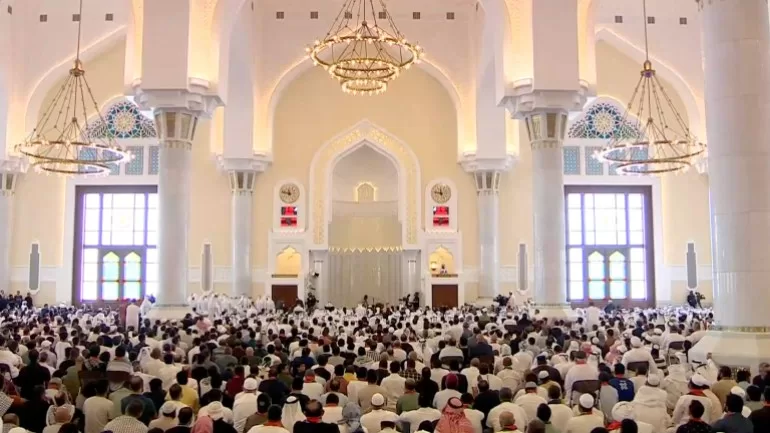Doha, Qatar – Thousands of people on Friday attended the funeral prayer for the late Hamas leader Ismail Haniyeh at Doha’s grand mosque amid tight security.
Haniyeh’s funeral prayer was attended by various Palestinian factions, diaspora groups, diplomatic dignitaries and nationals from many countries. He was laid to rest at Lusail royal cemetery north of the capital Doha on Friday afternoon.
Symbolic funeral prayers for Haniyeh have been organised in several Muslim countries, including Yemen, Jordan and Turkey.
Streams of mourners started to arrive at the Imam Muhammad ibn Abd al-Wahhab Mosque at about 9am, more than two hours before the Friday prayer, to bid farewell to the Hamas political chief who was assassinated in the Iranian capital Tehran in the early hours of Wednesday morning.
Men and women, many of them wearing the keffiyeh, the traditional Palestinian scarf, and carrying Palestinian flags, came to attend the funeral prayers despite Doha’s punishing heat, which hovered around 45 degrees Celsius (113 degrees Fahrenheit).
His body was brought to Doha on Thursday after a memorial event in Tehran, which was attended by thousands of people and where funeral prayers were led by the country’s Supreme Leader Ayatollah Ali Khamenei. Iranians waved Palestinian flags and carried pictures of the 62-year-old Hamas leader as they took part in the funeral procession.
Haniyeh, who was the diplomatic face of Hamas based in Qatar, was assassinated in his accommodation in Tehran. He was in the Iranian capital to attend the inauguration of Iranian President Masoud Pezeshkian. Israel has not publicly claimed responsibility. Fuad Shukr, a senior commander with the Lebanese armed group Hezbollah, an ally of Hamas, was also killed by Israel hours before Haniyeh’s assassination.

Tributes
Hassan Abu Dhr, who lost his leg and hand in an Israeli bombing on Gaza’s Bureij refugee camp in November, came to the funeral prayer to pay tribute to Haniyeh.
“We are in grief. We feel so sad because of his killing. He was like our father,” the 24-year-old, who was evacuated to Qatar for medical treatment, told Al Jazeera. “Ismail Haniyeh was the pride of Gaza. We trusted him, he was the best leader for Gaza.”
Syed Ziaullah, a Pakistani national, also attended the funeral prayers.
“I came here for him; it’s a relationship of brotherhood among Muslims,” Ziaullah told Al Jazeera. “He is a martyr and a patriot who struggled to free Palestine from Israeli occupation.”
Others who were in attendance were from different countries including Sudan, India and Bangladesh.
Many people Al Jazeera spoke to expressed solidarity with Palestinians in Gaza, who have been facing Israeli bombardment for the past 10 months. Vast swaths of Gaza have been flattened and nearly 40,000 people have been killed since October 7, when Israel launched its military offensive in the wake of a Hamas-led attack inside its territory. At least 1,100 people were killed during the attack in southern Israel.
“I am here in support of Palestine and in support of our people who are facing genocide for the past 300 days. I am here I because am sad for the death of Ismail Haniyeh and for the death of [Al Jazeera’s] Ismail al-Ghoul and his colleague Rami al-Rifi,” 32-year-old Sara Abdelshafy told Al Jazeera. Al Jazeera Arabic journalist Ismail al-Ghoul and cameraman Rami al-Rifi were killed in an Israeli attack in northern Gaza on Wednesday.

‘Down to earth’
Haniyeh was a prominent figure and considered accessible and approachable by many in Gaza.
Haniyeh’s popularity partly came from the fact that he embodied a typical Palestinian in the Gaza Strip, said Fathi Nimer, a Palestine policy fellow at Al-Shabaka, a think tank based in the occupied West Bank.
“He was a refugee born in the Shati refugee camp … most Palestinians are refugees, especially those in Gaza. His family was ethnically cleansed from Asqalan [Ashkelon, in present-day Israel]. What made him very relatable to people is that he went to a UNRWA [United Nations Relief and Works Agency for Palestine Refugees in the Near East] school and worked to support his family,” Nimer told Al Jazeera.
“People talk about him about being very humble and a very down-to-earth person,” he added.
Haniyeh joined Hamas as a student and rose through the ranks to become Palestine’s only democratically elected prime minister in 2006 at the age of 44.
Despite living outside of Gaza since 2019, he was not shielded from the devastation of Israel’s war. About 60 members of his family have been killed, including three of his sons in April, as well as his grandchildren, nieces and nephews.
“Through the blood of the martyrs and the pain of the injured, we create hope, we create the future, we create independence and freedom for our people and our nation,” he said in April.
Haniyeh was a top negotiator in the efforts to secure a ceasefire in Gaza.
“Haniyeh was described as a moderate and a pragmatist — someone who could plan for the long term and someone who could negotiate and deal with nuances of negotiations,” Nimer said.
Haniyeh’s killing, he added, “will have undoubtedly negative consequences for the [ceasefire] negotiations”.
Israel has assassinated numerous leaders from Hamas, the Palestinian Liberation Organisation, and other Palestinian groups in the past. Haniyeh had himself escaped an Israeli assassination attempt in 2003 along with his mentor Sheikh Ahmed Yasin, the Hamas spiritual leader and founder.
Nimer said the recent assassinations could backfire on Israel. “Whenever someone is assassinated, instead of killing their memory, they make them into a martyr – a hero for all the people,” he told Al Jazeera.
With additional reporting by Virginia Pietromarchi
